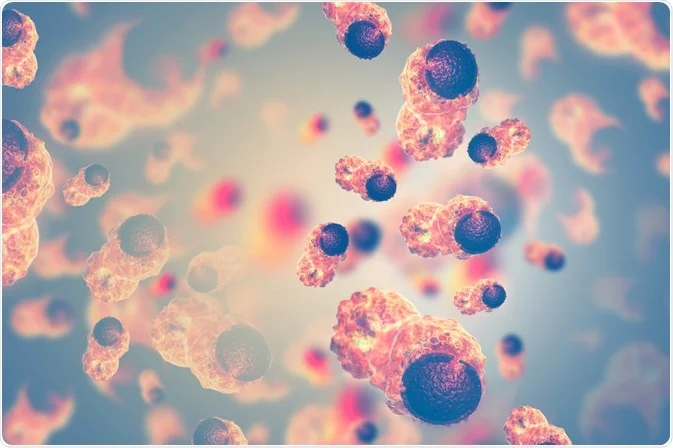NAD and Cancer: Is There a Link?

NAD (Nicotinamide Adenine Dinucleotide) is a molecule that plays a crucial role in the functioning of cells. But is there a link between NAD and cancer? If so, what is it?
It’s essential to understand this link to develop effective treatments and prevent any type of cancerous growth.
In this article, we talk about…
- How NAD influences the metabolism of cancer cells and what it means for treatment.
- The groundbreaking potential of NAD+ in revolutionizing cancer treatment strategies.
- Common misconceptions about NAD plus and its true impact on cancer, including surprising truths.
“Cancer cells have special metabolic features that contribute to survival, proliferation, and metastasis. A focal point for these metabolic changes is nicotinamide adenine dinucleotide (NAD+), where NAD+ levels in cells need to be balanced for processes to function effectively.” Sara Ryding, News Medical Life Sciences
Understanding NAD: An Overview
NAD is a coenzyme that is involved in numerous biological processes within cells. It’s a key player in energy metabolism, DNA repair, and cellular signaling pathways. NAD plus is a crucial molecule found in all living cells and is essential for their proper functioning.
One of the primary roles of NAD+ is its involvement in energy metabolism. It acts as a coenzyme for enzymes involved in cellular respiration, the process by which cells convert nutrients into energy.
NAD plays a critical role in the breakdown of glucose, fatty acids, and amino acids, allowing cells to produce adenosine triphosphate (ATP), the main source of energy for cellular processes.
NAD is also involved in regulating cellular processes such as aging, inflammation, and metabolism. It serves as a key component for the activation of enzymes called sirtuins, which play a vital role in maintaining cellular homeostasis.
Sirtuins are known to regulate gene expression, DNA repair, and cellular stress response, thereby influencing various aspects of our health and well-being.
NAD and Cellular Functions
In addition to its role in energy metabolism, NAD plays a vital role in maintaining the integrity of your DNA. It acts as a cofactor for enzymes involved in DNA repair mechanisms, ensuring that any damage to your genetic material is promptly and efficiently repaired. This helps prevent the accumulation of DNA mutations that can lead to cancer development.
Moreover, NAD is also involved in cellular signaling pathways, which are responsible for transmitting information within cells. It acts as a signaling molecule, participating in various cellular processes such as cell growth, differentiation, and apoptosis (programmed cell death).
NAD-dependent signaling pathways maintain tissue homeostasis and regulate cellular responses to external stimuli.
Additionally, recent research has shown that various factors, including diet, exercise, and lifestyle choices, can influence NAD plys levels. For example, calorie restriction and intermittent fasting1 have been found to increase NAD levels, which may contribute to their beneficial effects on health and longevity. Understanding the factors that influence NAD levels and their impact on cellular functions is an active area of research in the field of molecular biology.
In conclusion, NAD is a versatile coenzyme critical in various biological processes within your cells. From energy metabolism to DNA repair and cellular signaling, NAD is essential for maintaining cellular homeostasis and ensuring proper functioning.
Further research into the role of NAD+ and its regulation may provide valuable insights into developing novel therapeutic approaches for various diseases and conditions.
The Connection Between NAD+ and Cancer

Cancer is a complex disease that affects millions of people worldwide. Scientists and researchers have been studying various factors that contribute to the development and progression of cancer.
One such factor that has gained significant attention is Nicotinamide adenine dinucleotide (NAD), a molecule that plays a crucial role in cellular metabolism.
How NAD Influences Cancer Cell Metabolism
Research has shown that cancer cells have altered metabolic pathways compared to normal cells. These changes enable cancer cells to sustain their growth and proliferation. NAD+, being intricately involved in cellular metabolism, plays a significant role in promoting the survival and growth of cancer cells.
One way NAD influences cancer cell metabolism is through its involvement in energy production. Cancer cells exhibit a high demand for energy to support their rapid growth. NAD participates in key metabolic reactions, such as glycolysis and oxidative phosphorylation, which provide the necessary energy for cancer cells to thrive.
Additionally, NAD plus is involved in DNA repair mechanisms. Cancer cells often have damaged DNA due to genetic mutations or exposure to carcinogens2. NAD-dependent enzymes, such as poly(ADP-ribose) polymerases (PARPs), play a crucial role in repairing DNA damage. By manipulating the levels of NAD, researchers hope to develop targeted therapies that disrupt cancer cell metabolism and inhibit tumor growth.
NAD Levels and Cancer Progression
Studies have also demonstrated that the levels of NAD in cancer cells are often dysregulated. In some cases, cancer cells have elevated NAD levels, which contribute to their aggressive nature and resistance to treatment. This dysregulation can occur due to various factors, including genetic mutations or alterations in the expression of NAD biosynthetic enzymes.
Understanding the mechanisms that control NAD levels in cancer cells could pave the way for the development of new therapeutic strategies.
Researchers are investigating the role of NMN, such as nicotinamide riboside (NR) and NMN, in modulating NAD levels in cancer cells. These precursors have shown promising results in preclinical studies, suggesting their potential as adjuvant therapies in combination with conventional cancer treatments.
Furthermore, recent research has highlighted the interplay between NAD and other cellular processes implicated in cancer progression.
For instance, NAD has been found to regulate the activity of sirtuins, a family of proteins involved in various cellular functions, including DNA repair, metabolism, and aging.
Dysregulation of sirtuins has been linked to cancer development and progression. Therefore, targeting NAD and sirtuin pathways simultaneously could offer a multi-faceted approach to cancer treatment.
In conclusion, NAD+ plays a critical role in cancer cell metabolism and progression. Manipulating NAD levels and targeting NAD-dependent pathways hold promise for the development of innovative cancer therapies.
Further research is needed to fully understand the intricate relationship between NAD and cancer, paving the way for more effective and personalized treatment strategies.
The Potential of NAD+ in Cancer Treatment

When it comes to cancer treatment, researchers are constantly exploring new avenues to find more effective and less toxic options. One emerging area of interest is targeting NAD pathways, which have shown promise in disrupting the energy production and survival strategies of cancer cells.
NAD, or nicotinamide adenine dinucleotide, is a molecule that plays a crucial role in various cellular processes, including energy metabolism and DNA repair.
By selectively inhibiting enzymes involved in NAD metabolism, scientists believe they can hinder the ability of cancer cells to sustain their growth and proliferation.
One particular enzyme that has garnered attention is NAMPT, which is responsible for the production of NAD. Inhibiting NAMPT has been shown to reduce NAD levels in cancer cells, leading to impaired energy production and increased susceptibility to cell death. This approach holds great promise as a potential therapeutic strategy.
Targeting NAD Pathways for Therapy
Scientists are actively investigating different ways to target NAD pathways for cancer therapy. One approach involves the use of small molecule inhibitors that specifically block the activity of NAMPT.
These inhibitors have shown promising results in preclinical studies, demonstrating their ability to suppress tumor growth effectively.
Another avenue of exploration is targeting other enzymes involved in NAD metabolism, such as nicotinamide phosphoribosyltransferase (NAMPT).
By inhibiting these enzymes, researchers hope to disrupt the delicate balance of NAD levels in cancer cells, ultimately leading to their demise.
Furthermore, recent studies have highlighted the potential of combining NAD-modulating therapies with other treatment modalities, such as chemotherapy or immunotherapy.
This synergistic approach aims to enhance the effectiveness of existing cancer treatments by exploiting the vulnerabilities created by NAD pathway inhibition.
Challenges and Future Directions in NAD-Based Cancer Treatment
While the potential of NAD-based cancer treatment is exciting, there are still several challenges that need to be overcome before it can be translated into clinical practice.
One major hurdle is the development of specific and safe inhibitors that selectively target cancer cells without affecting normal cells. Achieving this selectivity is crucial to minimize off-target effects and reduce the risk of toxicity.
Researchers are actively working on designing and optimizing inhibitors that can precisely target the NAD pathways in cancer cells while sparing healthy cells.
Another challenge lies in determining the optimal timing and dosing of NAD-modulating therapies. The dynamic nature of NAD metabolism and its intricate involvement in various cellular processes make it essential to find the right balance between efficacy and toxicity.
Ongoing investigations aim to elucidate the optimal treatment regimens that maximize NAD-based interventions’ therapeutic benefits.
Furthermore, understanding the mechanisms of resistance to NAD pathway inhibition is crucial for the development of effective treatment strategies. Cancer cells are notorious for their ability to adapt and develop resistance to therapies, and NAD-based treatments are no exception.
Researchers can devise strategies to overcome or circumvent this challenge by unraveling the molecular mechanisms underlying resistance.
Debunking Myths: NAD and Cancer
Common Misconceptions About NAD and Cancer
There are several misconceptions surrounding the role of NAD in cancer. One common misconception is that boosting NAD levels can directly prevent or cure cancer. While NAD is undoubtedly important for cellular function, it is just one piece of the complex puzzle that is cancer development and progression.
The Scientific Truth: NAD’s Role in Cancer
Scientific evidence suggests that while NAD certainly contributes to cancer cell metabolism and progression, it is not solely responsible for the disease. Cancer is a multifactorial and complex disease, and understanding the role of NAD is just one aspect of the ongoing research aimed at unraveling its mysteries.
Conclusion: The Complex Relationship Between NAD and Cancer

In conclusion, NAD plays a significant role in cancer development and progression. Its involvement in cellular metabolism, DNA repair, and signaling pathways makes it an attractive target for therapeutic interventions. However, it is essential to recognize that NAD is just one piece of the intricate puzzle that is cancer, and further research is needed to fully understand its role in the disease.
The Future of NAD Research in Oncology
As scientists continue to explore the intricate relationship between NAD and cancer, new insights and breakthroughs are likely to emerge. Scientists are hopeful that by unraveling the complexities of NAD metabolism and its impact on cancer cells, they can develop more effective and targeted treatments that could someday revolutionize the field of oncology.
Conclusion
In conclusion, understanding the link between NAD and cancer is a crucial step in improving our ability to diagnose, treat, and ultimately prevent this devastating disease. Through continued research and exploration, we hope to shed more light on this complex relationship and pave the way for innovative therapies that can transform the lives of cancer patients. Are you deficient in NAD? Take this test to find out.




